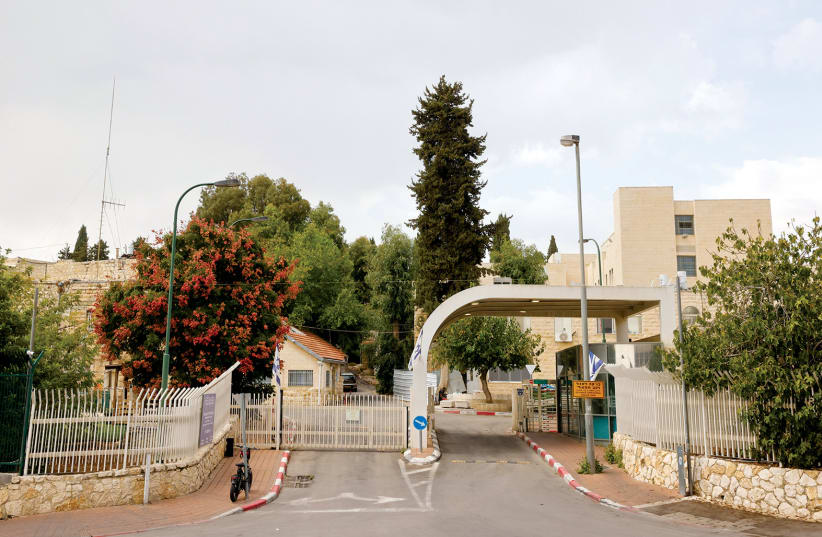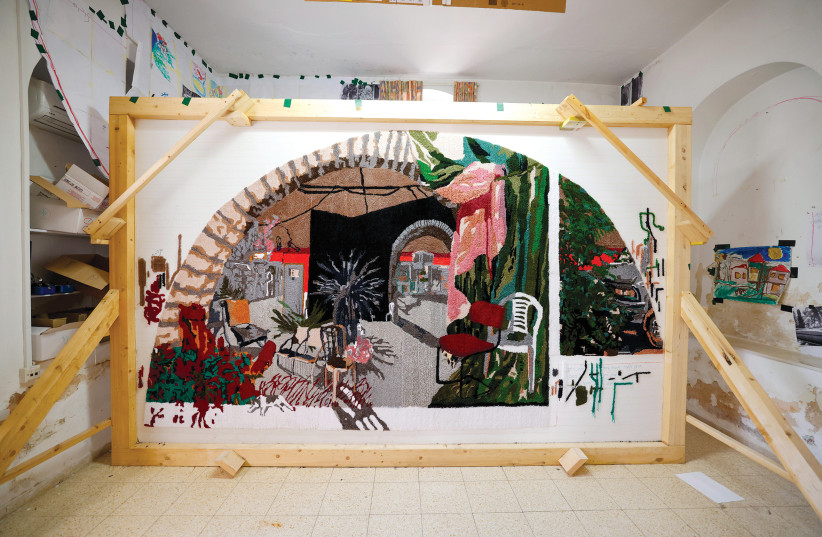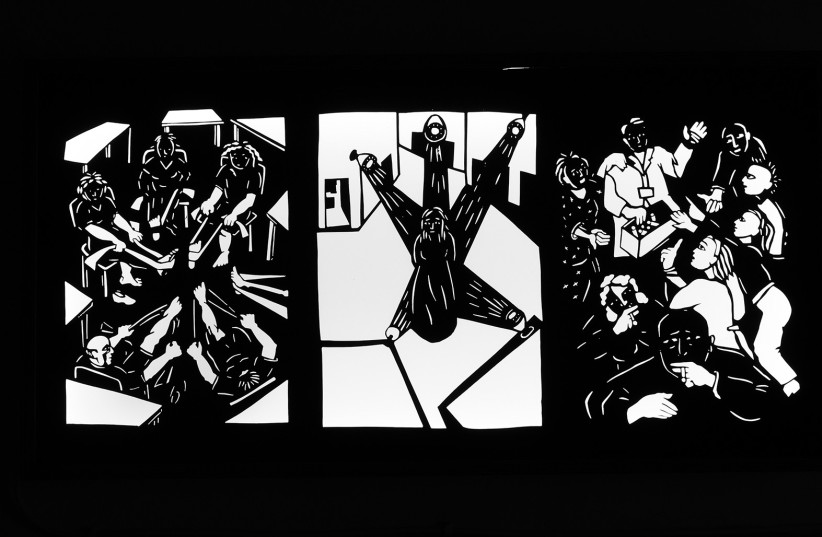Jerusalem Mental Health Center’s Kfar Shaul gated hospital may not be where you would think of going for an exhibition of first-class art. But actually, given what’s on display now in an ongoing show of works by patients in collaboration with professional artists, it makes a lot of sense.
Dr. Gadi Lubin, the head of the center, encompassing the citywide psychiatric sprawl that includes Kfar Shaul hospital, Eitanim hospital and more than 30 clinics, is the enthusiastic proponent of an imaginative and self-reflective art exhibition.
The exhibition was conceived by artists, many of whom have either been patients themselves or are currently patients at Kfar Shaul.
Lubin is keenly aware of the shift of energy on the hospital grounds as a result of the exhibition and is excited to welcome the public to experience it as well.
“When patients interact with artists, it puts them in a different frame of mind when they wake up in the morning. They say to themselves, ‘I did something meaningful yesterday. I can do things. I have potential,’” Lubin explained.
“Those who suffer from mental health crises might have very low self-esteem and low self-expectations, so when you encourage them to take part in creating artwork, the feedback, which has been very positive and warm, challenges negative assumptions the patients might have about their creative abilities and beyond.”
“Those who suffer from mental health crises might have very low self-esteem and low self-expectations, so when you encourage them to take part in creating artwork, the feedback, which has been very positive and warm, challenges negative assumptions the patients might have about their creative abilities and beyond.”
Dr. Gadi Lublin
This project is the brainchild of Tel Aviv curator Iris Pshedezki, a gallerist and director of the NGO, The Refrigerator. Pshedezki has combined her sophisticated sensibilities with curatorial and social expertise to put together a truly remarkable exhibition with heart.
“The Refrigerator’s aim,” she said, “is to initiate art projects and art exhibitions. We have a small gallery in Tel Aviv. I dreamed about the project, raised money for it, and after I obtained a certain amount to produce it, I teamed up with Izi Civre, a longtime curator at the Janco-Dada Museum in Ein Hod.”
Civre shares Pshedezki’s passion to make art accessible to not only people with disabilities and special needs but also the communities where their clinics and hospitals are situated.
“The people who were part of the program came from all kinds of backgrounds and points of view,” Pshedezki continued. “Izi and I are also members of a small collective that’s part of The Refrigerator, which focuses on accessibility. We produce events that talk about accessibility as part of art theory, and do art events that focus on these issues, involving artists and curators with and without disabilities.”
Pshedezki made clear that what’s on display at Kfar Shaul is not art therapy according to the classic definition – that is, a form of psychotherapy created with a trained art therapist to encourage free self-expression and used to aid in diagnosis and treatment.
“I think that if I came to Kfar Shaul with this idea for an art exhibition as a therapist, I wouldn’t have anything to say to them because they have art therapists. They don’t need me. The main point was to do something not therapeutic, to engage with the community of patients, and then open the hospital to not just patients.”
From the beginning, Pshedezki knew that she needed to build a strong group of artists to go into the hospital and deal with the complicated issues that arise in hospital ward settings with both an insider’s and an outsider’s point of view.
“We didn’t want to do something patronizing. We know that if we do a regular art project, it’s very dangerous because it’s very complicated to talk about another person’s feelings and emotions without knowing about it yourself.”
Pshedezki and Civre conceived a project to seek out former and current patients with strong art backgrounds and enlist them to create art at the hospital with the participation of patients. In some cases, the artwork was made solely by former patients.
The show stopper is a monumental tufted rug, conceived by Yarden Colsey and Deborah Fischer, with the participation of Kinneret Meimoun, Aharon Cohen and patients from Department B, who chose to remain anonymous. Colsey and Fischer worked with patients in the open ward to design the carpet using photos of scenes from Kfar Shaul taken by patients.
“Five patients would come to a cottage turned into their art studio every day and treat it like work, with a lively atmosphere of music and food,” said Hadas Tidhar, the administrative director of the Kfar Shaul campus and overseer of the project.
Efrat Yagur, a social worker, professional artist and former patient at Kfar Shaul, worked independently, dealing in this exhibition with the question of what it means to be hospitalized. Yagur collected 6,000 cigarette butts, which are artfully contained in a Plexiglas box.
“With Efrat’s [collection of] cigarette butts, she tries to make something that represents the feelings of patients here, how they feel bored and resort to smoking, even though we feel we give them a lot of opportunities,” said Tidhar. “For the patients, there’s group therapy, books, activities in the afternoon, sports music, gardening, talking with nurses and social workers. But if she feels [it is] boring, it’s an opportunity for us to try to be better... [an] opportunity to learn about the feelings of the patients through their eyes.
“In all the projects that The Refrigerator does, the agenda is the same. We build collectives for people who have personal experience with disabilities,” said Pshedezki.
“As artists and curators, we ask how can an art exhibition be relevant for everyone? What’s blocking the public from being engaged?
“The collective tries to raise the question and do art events that are more inclusive. We also try do other kinds of events in which this is a theme, such as a poetry day that focuses on coping with mental health. We also have a group of artists who work together to learn about the connection between disability and art.”
Out of 40 art proposal submissions, eight were accepted to be part of a one-month project culminating in the current exhibition.
“There were supposed to be six artists,” Pshedezki said, “but we had submissions from a mother and son, and a couple, so eventually it became eight.”
Patricia O’Donovan brought her gifts to the exhibition in a variety of ways as an artist specializing in cutouts mounted in light boxes. She had been hospitalized five years ago, and from that experience she did 48 cutouts showing scenes of how patients spend their time at the hospital – beyond smoking cigarettes and group therapy – to the feeling that she was being watched by cameras everywhere.
In the second cutout series, she, together with her son David, worked with patients and joined them in workshops to make collaborative cutouts using her strong yet whimsical shadow puppetry techniques.
A three-year project to open the grounds to the public
When Pshedezki met Tidhar and first suggested that artists come and work together in this residential project, she got the nod but was told that she’d have to seek the funding. Pshedezki succeeded in obtaining pledges of support from the Jerusalem Foundation, the Mifal Hapayis national lottery, and Keren Yedidim, friends of the Jerusalem Mental Health Center to cover the essential art supplies and the artists’ stipends.
“Patients joined on a voluntary basis. Those who wanted to participate had curiosity and interest in art. For those who suffer from acute mental disorder, lack of motivation or were lethargic, we encouraged them. There are long-term residents who spend weeks to years here. The average stay is about 30 days, but most who participated were longer-term residents,” Tidhar said.
“This past June,” Pshedezki said, “the eight artists came to Kfar Shaul to begin. For those new to the hospital setting, they learned about the history, what goes on here, and they started to work with the patients.
“Every artist met the patient once or twice a week for one month. The artwork was made with specific locations in mind – the hospital dining room, the emergency room, the art studio building, and exterior walls of buildings in the village.”
In Lubin’s long career specializing in adult psychiatry, he served as the head of the mental health department in the IDF between 2005 and 2010, concentrating on training, research and treatment having to do with stress-related disorders and suicide prevention. He sees much potential in art exhibitions of this kind.
“Generally speaking, there has been a change in the general attitude toward the idea of letting people from different populations, not only the patients, enter and visit psychiatric locations that belong to the Jerusalem Mental Health Center,” he noted. “There’s a tension between protecting the privacy of the patient on one hand, and on the other hand, we don’t want to be behind the walls. The fact that there are walls and [the center] was off limits [to the public] contributes to the stigma of the field and the stigma of the treatments.
“It’s not just that we opened the sites. We opened our grounds in a sophisticated way, by entering the field of art through this village and through the people living in the village.
“Art wasn’t one of our main ways of treatment, honestly speaking. In the military service, we were very much focused on arvut hadadit, platoon solidarity among the soldiers and providing mental health advice and support,” Lubin said.
“For many years there were different assumptions in the field of mental health,” he continued. “There were the biologists, who focused mainly on drugs, and those that are more conservative that concentrated on psychotherapy and treatments in the way of Sigmund Freud, Carl Jung and many others.
“Now we know that this split is very superficial and based on wrong assumptions. We know that the mental world is much more integrated, and part of our new understanding is that we should adopt an integrative attitude and a holistic one.
“The pathways that we can use now in therapies are much more varied in bridging two people, which is the doctor or treater, and the patient. There are many ways to combine therapies. There is art, there is music, and there’s nature, for example. We know that exposure to nature in certain cultures is a powerful approach to therapy.”
UNTIL 1990, Israel had 7,500 psychiatric beds in about 70 hospitals, most of them private, in a population of 3.5 million. Now, in a population of almost nine million, Israel counts 3,200 beds, with the prevailing attitude of getting patients integrated back into the community when they have recovered.
Five years ago, “Through the Eyes of the Artists,” a collaborative exhibition between Eitanim and Kfar Shaul hospitals, was initiated by Dr. Gregory Podolsky, a manager of one of the psychiatric departments at Kfar Shaul. He recruited artists – Russian immigrants – to visit the village and paint scenes of the old Arabic architecture shaded by tall trees.
“Long before Kfar Shaul was established, this had been an Arab village, and a placement center from 1948 to 1950 for new immigrants,” Lubin said. “During the War of Independence, on April 8, there was a battle here in which there were casualties, among them a number of soldiers, fighters and, significantly, unarmed Arab villagers. For us, working in this village is a kind of expression of tikkun olam because we treat Arabs, Jews, Orthodox, non-Orthodox, and they are also part of the staff.
“Kfar Shaul actually reflects our real ability to live together and create harmony between us.” ❖
For more details about the exhibition: kfarshaulart.co.il
The exhibition is open to the public through November 5, and thereafter can be seen by appointment. To arrange for a viewing, contact hadas.ti@moh.gov.il
The writer is an intuitive art teacher and founder of Genesis Art Workshops of Israel and Japan. www.genesiscards.com


